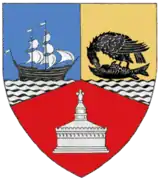Ostrov, Constanța
Ostrov is a commune in Constanța County, Northern Dobruja, Romania.
Ostrov | |
|---|---|
 Location in Constanța County | |
 Ostrov Location in Romania | |
| Coordinates: 44°6′33″N 27°21′50″E | |
| Country | |
| County | Constanța |
| Subdivisions | Ostrov, Almălău, Bugeac, Esechioi, Galița, Gârlița |
| Government | |
| • Mayor | Niculae Dragomir (PSD) |
| Area | 171.30 km2 (66.14 sq mi) |
| Population (2011)[1] | 5,069 |
| • Density | 30/km2 (77/sq mi) |
| Time zone | EET/EEST (UTC+2/+3) |
| Vehicle reg. | CT |
| Website | www |
Name
The name Ostrov is a word of Bulgarian origin and it means "island".[2] The village itself is not located on an island, but rather on the banks of the Danube.
Villages
The commune includes six villages:
Geography
Ostrov is close to the Bulgarian border, with a border crossing linking it to the Bulgarian city of Silistra. The locality was a town until 1950.
Demographics
At the 2011 census, Ostrov had 4,730 Romanians (95.54%), 187 Roma (3.78%), 30 Turks (0.61%), 4 others (0.08%).[3]
Păcuiul lui Soare


Păcuiul lui Soare is the name of a fortress on an island close to Ostrov. The ruins from the beginning of 8th century belong to the "Glorious Palace" of the First Bulgarian Khans on Danube and main base of the Bulgarian Danube fleet, as researchers suppose.[4] They found many Protobulgarian marks graved in the blocks of the stone masonry of fortress that build pretty similar to the imperial capital Pliska.[5] The stone graving text from the "Holy 40 martyrs column" found in Tarnovo indicate that the Great Khan Omurtag (?-831) built, maybe over Byzantine ruins, the medieval port and palace complex.[6]
References
- "Populaţia stabilă pe judeţe, municipii, oraşe şi localităti componenete la RPL_2011" (in Romanian). National Institute of Statistics. Retrieved 4 February 2014.
- World loanwords vocabulary - ostrov, a word from Romanian, status: clearly borrowed from Slavic.
- "Constanța County at the 2011 census" (PDF) (in Romanian). INSSE. February 2, 2012. Archived from the original (PDF) on March 24, 2012. Retrieved March 8, 2012.
- Juhas, Petar. Turko-Bulgarians and Magyars.
- Vaklinov, Stancho (1981). Proto-Bulgarian Epigraphic Monuments. Publishing House of the Fatherland Front Sofia.
- Beshevliev, Vesselin (1977). Formation of the Old-Bulgarian Culture. Naouka i Izkoustvo Publishing House Sofia.
External links
- (in Romanian) Ostrov at the Constanța County Council website
